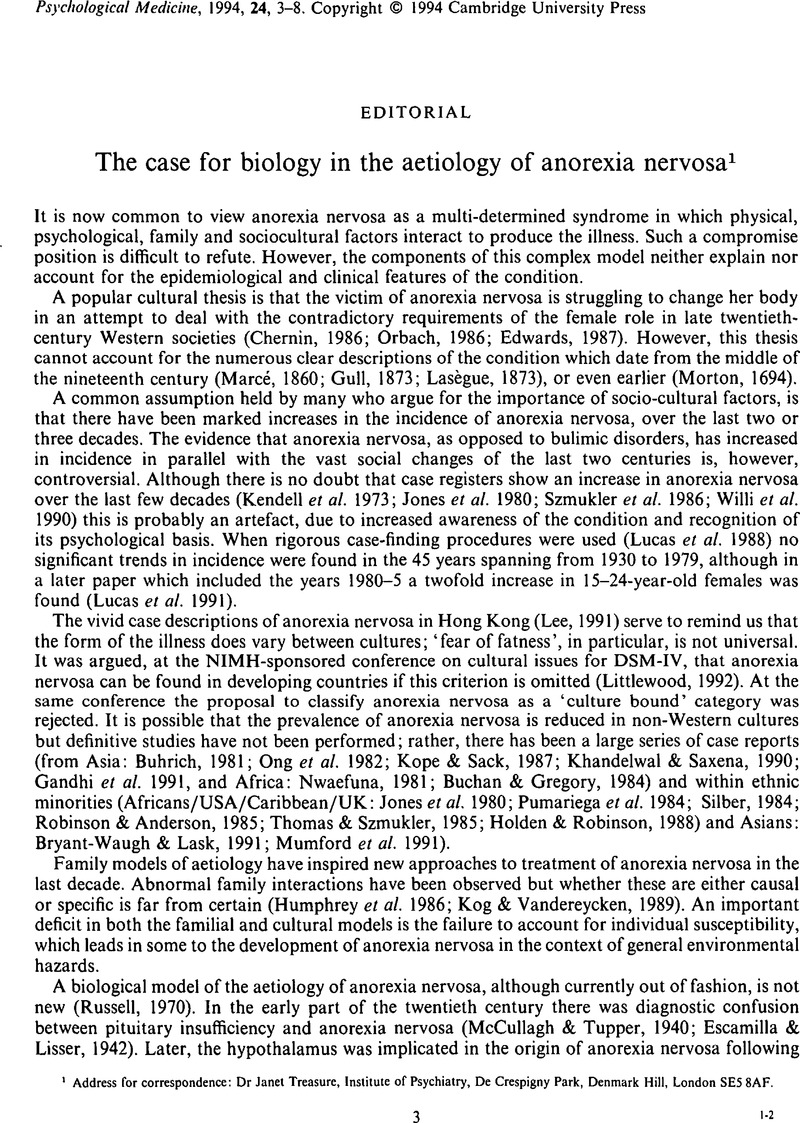Crossref Citations
This article has been cited by the following publications. This list is generated based on data provided by Crossref.
Hartman, D
1995.
Anorexia nervosa--diagnosis, aetiology, and treatment.
Postgraduate Medical Journal,
Vol. 71,
Issue. 842,
p.
712.
Sulway, M. R.
Broe, G. A.
Creasey, H.
Dent, O. F.
Jorm, A. F.
Kos, S. C.
and
Tennant, C. C.
1996.
Are malnutrition and stress risk factors for accelerated cognitive decline? A prisoner of war study.
Neurology,
Vol. 46,
Issue. 3,
p.
650.
Wakeling, A.
1996.
Epidemiology of anorexia nervosa.
Psychiatry Research,
Vol. 62,
Issue. 1,
p.
3.
Lee, Sing
1997.
How lay is lay? Chinese students' perceptions of anorexia nervosa in Hong Kong.
Social Science & Medicine,
Vol. 44,
Issue. 4,
p.
491.
STRIEGEL‐MOORE, RUTH H.
1997.
Risk Factors for Eating Disorders.
Annals of the New York Academy of Sciences,
Vol. 817,
Issue. 1,
p.
98.
Kaye, Walter
Gendall, Kelly
and
Strober, Michael
1998.
Serotonin neuronal function and selective serotonin reuptake inhibitor treatment in anorexia and bulimia nervosa.
Biological Psychiatry,
Vol. 44,
Issue. 9,
p.
825.
Ward, Anne
Brown, Nigel
Lightman, Stafford
Campbell, Iain C.
and
Treasure, Janet
1998.
Neuroendocrine, appetitive and behavioural responses to d-fenfluramine in women recovered from anorexia nervosa.
British Journal of Psychiatry,
Vol. 172,
Issue. 4,
p.
351.
Tiller, Jane
and
Treasure, Janet
1998.
Eating disorders precipitated by pregnancy.
European Eating Disorders Review,
Vol. 6,
Issue. 3,
p.
178.
Pieri, Lorenzo F.
and
Campbell, David A.
1999.
Understanding the genetic predisposition to anorexia nervosa.
European Eating Disorders Review,
Vol. 7,
Issue. 2,
p.
84.
Tsai, Grace
2000.
Eating disorders in the Far East.
Eating and Weight Disorders - Studies on Anorexia, Bulimia and Obesity,
Vol. 5,
Issue. 4,
p.
183.
Kaye, W. H.
Klump, K. L.
Frank, G. K. W.
and
Strober, M.
2000.
Anorexia and Bulimia Nervosa.
Annual Review of Medicine,
Vol. 51,
Issue. 1,
p.
299.
Hetherington, Marion M
2000.
Eating disorders: diagnosis, etiology, and prevention.
Nutrition,
Vol. 16,
Issue. 7-8,
p.
547.
Klump, Kelly L.
Kaye, Walter H.
and
Strober, Michael
2001.
THE EVOLVING GENETIC FOUNDATIONS OF EATING DISORDERS.
Psychiatric Clinics of North America,
Vol. 24,
Issue. 2,
p.
215.
Frank, Guido K
Kaye, Walter H
Meltzer, Carolyn C
Price, Julie C
Greer, Phil
McConaha, Claire
and
Skovira, Kelli
2002.
Reduced 5-HT2A receptor binding after recovery from anorexia nervosa.
Biological Psychiatry,
Vol. 52,
Issue. 9,
p.
896.
Kaye, Walter H.
Devlin, Bernie
Barbarich, Nicole
Bulik, Cynthia M.
Thornton, Laura
Bacanu, Silviu‐Alin
Fichter, Manfred M.
Halmi, Katherine A.
Kaplan, Allan S.
Strober, Michael
Woodside, D. Blake
Bergen, Andrew W.
Crow, Scott
Mitchell, James
Rotondo, Alessandro
Mauri, Mauro
Cassano, Giovanni
Keel, Pamela
Plotnicov, Katherine
Pollice, Christine
Klump, Kelly L.
Lilenfeld, Lisa R.
Ganjei, J. Kelly
Quadflieg, Norbert
and
Berrettini, Wade H.
2004.
Genetic analysis of bulimia nervosa: Methods and sample description.
International Journal of Eating Disorders,
Vol. 35,
Issue. 4,
p.
556.
Léonard, T.
Foulon, C.
and
Guelfi, J.-D.
2005.
Troubles du comportement alimentaire chez l'adulte.
EMC - Psychiatrie,
Vol. 2,
Issue. 2,
p.
1.
Hochdorf, Zipora
Latzer, Yael
Canetti, Laura
and
Bachar, Eytan
2005.
Attachment Styles and Attraction to Death: Diversities Among Eating Disorder Patients.
The American Journal of Family Therapy,
Vol. 33,
Issue. 3,
p.
237.
Roerig, James L
Mitchell, James
and
Steffen, Kristine J
2005.
New targets in the treatment of anorexia nervosa.
Expert Opinion on Therapeutic Targets,
Vol. 9,
Issue. 1,
p.
135.
Léonard, T.
Foulon, C.
and
Guelfi, J.-D.
2005.
Troubles du comportement alimentaire chez l'adulte.
EMC - Psychiatrie,
Vol. 2,
Issue. 2,
p.
96.
Bulik, Cynthia M
Hebebrand, Johannes
Keski-Rahkonen, Anna
Klump, Kelly L.
Reichborn-Kjennerud, Ted
Mazzeo, Suzanne E.
and
Wade, Tracey D.
2007.
Genetic epidemiology, endophenotypes, and eating disorder classification.
International Journal of Eating Disorders,
Vol. 40,
Issue. S3,
p.
S52.



